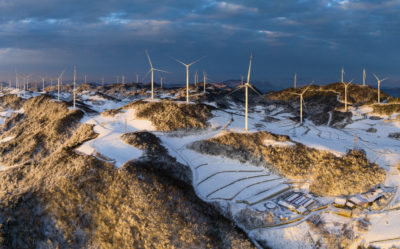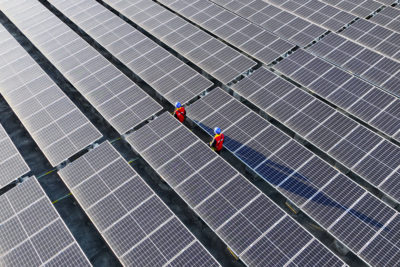Last November, Chinese language language native climate envoy Xie Zhenhua and U.S. native climate envoy John Kerry shook palms on a pledge to triple renewable energy globally by 2030. It was hailed as a welcome revival of native climate cooperation between the world’s largest and second-biggest emitters of greenhouse gases and provided hope that the two veteran native climate negotiators had found a strategy by way of a blizzard of unfavorable diplomatic exchanges to take care of alive the prospects for bigger world ambition on tackling native climate change.
In a single key sector necessary to that ambition, nonetheless, the Chinese language language authorities can argue, with some justification, that it is China, not the USA, that is inside the lead. In a world throughout which nationwide native climate targets are being missed, the speed and scale of enlargement in China’s put in renewable functionality is unmatched.
In 2020, as an example, China pledged to achieve 1,200 gigawatts of renewables functionality by 2030, better than double its functionality in the mean time. At its present tempo, it’s going to meet that target by 2025, and can boast as loads as 1,000 gigawatts of photo voltaic power alone by the tip of 2026, an achievement which will make a substantial contribution to the 11,000 gigawatts of put in renewable functionality that the world desires to fulfill the 2030 targets of the Paris Settlement. Fossil fuels now make up decrease than half of China’s complete put in know-how functionality, a dramatic low cost from a decade prior to now when fossil fuels accounted for two-thirds of its power functionality.
In 2022, China put in roughly as loads picture voltaic functionality as the rest of the world combined, then doubled additional picture voltaic in 2023.
When the Worldwide Energy Authority issued its analysis of the pledge to triple renewables globally by 2030, it recognized that the 50 p.c enhance in world renewable installations in 2023 was largely pushed by China. In 2022, China put in roughly as loads picture voltaic photovoltaic functionality as the rest of the world combined, then went on in 2023 to double new picture voltaic installations, enhance new wind functionality by 66 p.c, and practically quadruple additions of energy storage.
For the earlier 20 years, China has been notorious as a result of the world’s largest emitter of greenhouse gases, a country that moreover makes use of as loads intently polluting coal as the rest of the world combined. How did it moreover grow to be the world’s renewable powerhouse?
Part of the reply goes once more to funding selections made inside the mid-2000s when China’s decades-long a part of quick GDP progress was coming to an end. Labor costs had been rising, and China’s enchancment model, with its overwhelming dependence on coal, had plunged China into quite a lot of crises of air, soil, and water air air pollution. Throughout the first decade of this century, China’s emissions better than doubled, and by 2006 it had overtaken the U.S. to earn the unwelcome title of the world’s largest emitter of greenhouse gases by amount.

A wind farm in Yichang.
Costfoto / NurPhoto / AP Image
China’s administration was alert to the unfavorable diplomatic impacts of being the world’s worst polluter, significantly in these worldwide areas most weak to native climate impacts. On the equivalent time, China’s private publicity to native climate change outcomes, on excessive of its escalating air air pollution catastrophe and most people unrest it was producing, was turning into a significant matter in Beijing’s top-level protection discussions. China’s planners had been looking for investments which will create an opportunity for a additional superior technological future, and this coincided with the need to clear up China’s setting and the worldwide effort to cut emissions. All this pointed to supporting the occasion of the renewable utilized sciences the world would want if it was to avoid native climate catastrophe.
Throughout the subsequent and every subsequent five-year plan, China made strategic investments in all factors of renewable utilized sciences, from picture voltaic and wind functionality, inexperienced hydrogen, and geothermal duties to evaluation and funding in battery storage and its present chains. Throughout the first a part of its quick industrial enchancment starting inside the Nineteen Nineties, China had been obliged to license utilized sciences owned by others. Now the strategic ambition was to dominate the sector, positioning China because the worldwide supplier of merchandise to an increasingly more carbon-constrained world.
If China has been clear regarding the different facet of native climate change, it has been a lot much less obsessive about decreasing its private emissions.
Inside a decade, China had largely achieved its intention of dominating not solely the manufacturing of picture voltaic and wind utilized sciences, nevertheless it had developed a near monopoly on all sides of the supply chains, along with the mining and processing of the rare-earths and strategic minerals necessary for the clear energy revolution. Proper this second, China has better than 80 p.c of the world’s picture voltaic manufacturing functionality. The extraordinary scale of China’s renewables sector output has pushed down prices worldwide, and this could be a key take into account lowering the worth barrier to renewable packages for poorer worldwide areas. Proper this second China not solely holds needed positions in wind and battery utilized sciences, nevertheless a Chinese language language agency, BYD, has grow to be the world’s largest EV producer, and China is poised to pose a formidable world drawback in all factors {of electrical} transportation to established automobile producers.
However when China has been clear regarding the different facet of native climate change, it has been a lot much less obsessive about decreasing its private emissions: Throughout the first 20 years of the century, the monetary system remained overwhelmingly relying on coal, and China argued that committing to major cuts in emissions may be an unfair constraint on its correct to develop. That began to differ with President Xi Jinping’s shock announcement on the 2020 U.N. Regular Assembly that China would peak its emissions “properly sooner than” 2030, as a result of it had promised in Paris in 2015, and in an needed new present, that it may objective for carbon neutrality by 2060. A radical renewables program may be necessary to meeting these targets.
Xi Jinping’s announcement attracted world consideration, nevertheless its most inspiring influence was at residence. It despatched a strong political register favor of renewable investments all through China, and the nation’s giant state-owned enterprises, along with its standard energy corporations, had been compelled to take uncover, every of Xi’s unequivocal message and the protection initiatives it triggered. The Nationwide Energy Administration (NEA), the physique that regulates China’s energy sector, moreover acknowledged that new insurance coverage insurance policies and mechanisms may be needed if China was to implement Xi’s targets.
Big wind farms had been already working in northern China, and now a set of utility-scale clear energy bases involving a number of China’s giant state-owned utility corporations had been deliberate for the comparatively empty western desert areas. These bases, a mixture of enormous picture voltaic arrays and wind farms, are to be linked to markets in japanese China by way of high-speed transmission traces. The duties take profit every of extreme picture voltaic radiation inside the desert and large portions of low value, obtainable land. China targets to assemble better than 200 such bases to help to raise its renewables functionality to about 3.9 terawatts by 2030, better than 3 instances its 2022 complete.
China nonetheless generates about 70 p.c of its electrical power from fossil fuels, as renewable energy use lags behind put in functionality.
Together with these desert duties, the NEA promised in 2021 to boost rural grid transmission and allow village collectives to place cash into distributed renewable power and share the benefits. To promote the adoption of distributed rooftop picture voltaic, the NEA launched the Full County PV program, a nationwide pilot scheme that aimed to place in photovoltaics in roughly half of China’s county-level rural administrations, comprising a couple of quarter of China’s inhabitants. This technique set targets of providing picture voltaic to twenty p.c of residential properties, with separate targets for industrial buildings.
The utility-scale developments had neglected China’s additional scattered rural populations, so displaying curiosity in a rural model throughout which purchasers every draw energy down and promote energy once more to the grid was a radical departure for China’s standard central planners and grid operators. The NEA now aimed to include China’s neglected rural inhabitants inside the renewable revolution. By the tip of 2022, 676 counties had signed up for the scheme, and better than 51 gigawatts of current distributed picture voltaic photovoltaic was put in, virtually half of it on from rural rooftops. In complete, by the tip of 2022, China had constructed roughly 157 gigawatts of distributed photovoltaic functionality, better than double that of the U.S.

Employees study a rooftop picture voltaic array in Fuzhou, China.
Costfoto / NurPhoto by way of AP
The NEA moreover launched plans to develop the financing channels for renewables and improve incentives and market mechanisms, aiming to shift the state-owned banks from favoring state-owned enterprises and from undervaluing every the personal sector and new protection initiatives.
Proper this second the renewables sector is probably going one of many comparatively few good spots inside the Chinese language language monetary system, having benefited from a surge in authorities stimulus as Beijing tried to revive progress hit arduous by Covid-19. The large precise property market, which boosted China’s GDP figures for better than three a very long time, is teetering on the sting of collapse. The pandemic and the downturn in world economies that adopted has hit China’s exports, and nervous Chinese language language buyers are sitting on their wallets in case points worsen. Renewable energy, nonetheless, seems to have an excellent future, nevertheless completely realizing that potential will demand further radical reforms.
Renewables now account for half of China’s put in functionality, nevertheless there has moreover been a surge in permits for model spanking new coal-fired power vegetation, and China nonetheless generates about 70 p.c of its electrical power from fossil fuels. This suggests exact renewable energy use is lagging behind put in functionality.
The federal authorities has launched plans to create a unified electrical power system, merging regional grids into one nationwide market.
That’s largely due to points with China’s giant grid, which prefers high-speed transmission from reliable sources to the issue of integrating variable renewable power and the associated drawback of matching intermittent present to demand. For the grid corporations, China’s coal-fired power vegetation are common and predictable, and so they’re allowed many additional hours of grid entry than renewables. In addition to, anxieties about energy security in the mean time are extreme on the protection agenda, strengthened by geopolitical tensions and updated droughts that affected hydropower output and resulted in power cuts. In China, energy security nonetheless means coal.
China’s current native climate and energy ambitions are embedded in a set of protection statements, along with its current five-year plan. Although China’s political custom areas a heavy premium on meeting its declared targets, quite a lot of energy and native climate commitments are at current off monitor, largely because of the energy sector’s persevering with dependence on coal.
In 2021, inside the Paris Settlement commitments that China submitted to the U.N., Beijing pledged to “strictly prohibit” coal progress, strictly administration new coal power, cut back energy and carbon depth by 2025, enhance the share of non-fossil energy sources to twenty p.c by 2025 and to 25 p.c by 2030, and to generate 50 p.c of the rise in energy use from 2020 to 2025 from renewable sources. Faraway from limiting coal progress, nonetheless, based mostly on analysis by Carbon Transient, a model new coal rush is underway as operators seize what they see as in all probability the ultimate different for model spanking new vegetation.

An EV battery manufacturing facility in Nanjing.
Attribute China / Future Publishing by way of Getty Images
The figures confirm the sample: The widespread progress worth of coal consumption elevated eightfold inside the remaining two years, from 0.5 p.c per yr between 2016 and 2020 to 3.8 p.c per yr between 2021 and 2023, and new coal power approvals quadrupled between 2022 and 2023 as in distinction with the 5 years sooner than the federal authorities pledged its strict controls.
This has contributed to a 12 p.c rise in emissions inside the energy sector between 2020 and 2023. To fulfill the federal authorities’s 2025 carbon depth targets, emissions should peak this yr and decline by 4 to 6 p.c by 2025. Some analysts ponder these targets already out of attain, however when China is to stay on observe with its long- and short-term targets, the federal authorities ought to honor its pledge to handle new coal functionality and proceed its quick buildup of renewables.
To utilize its renewables functionality successfully nonetheless, China has acknowledged that power system reforms are prolonged overdue. The Nationwide Development and Reform Charge simply these days launched plans to create a unified nationwide power market by 2030, merging its six regional grids into one nationwide electrical power market to greater deal with fluctuations in present and demand. If which may be achieved, China could not solely enhance its place because the worldwide chief in put in functionality for renewable nevertheless may additionally make greater use of the clear energy it produces.
